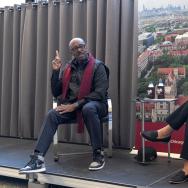When Asst. Prof. Janelle Goodwill first arrived in Chicago in 2020, she saw several news stories about gun violence in the city. But she also realized that many researchers had not yet explored a related, concerning trend. Suicides—particularly in Black communities—were increasing.
“I noticed that there was a gap between what I was seeing in the media and this nascent, understudied area of empirical research,” said Goodwill, the Neubauer Family Assistant Professor at the University of Chicago’s Crown Family School of Social Work, Policy, and Practice. “I felt like there was a gap that needed to be filled.”
In a recent study published in the American Journal of Public Health, Goodwill and senior research analyst Rachel Baccile of the UChicago Center for Health and the Social Sciences analyzed suicide deaths from 2015-2021 to measure differences across race, ethnicity, age and sex groups in Chicago.
They found that suicide rates increased among Black men and women, Asian women and Latino men during that time span. For both White women and men, suicide rates had decreased, though White men continued to have the overall highest rate of suicide deaths.
The analysis also showed that Black and Latino residents in Chicago were dying by suicide at an earlier age than people in White and Asian communities.
The researchers also looked at the methods by which people ended their lives to find patterns that could lead to changes in intervention strategies.
“There are national narratives around violence in Chicago, particularly as it relates to homicide,” Goodwill said. “This study is important because, for me, it is pushing back and offering a different critique around what violence actually looks and feels like for Chicago residents. Suicides are happening right underneath our noses.”
Analyzing patterns
Goodwill has studied suicide prevention for over ten years. After accompanying a friend to the emergency room who was in the midst of a mental health crisis, she was shocked at the challenges they encountered when seeking help.
“It was a really painful, but illuminating encounter that showed me that even once somebody makes it to an emergency room, there are still a lot of barriers they face,” Goodwill said. “I began to wrestle with thinking about all the folks who don't even make it to an emergency room.”
In 2020, Goodwill read news stories by journalist Lakeidra Chavis, whose reporting helped raise awareness about the spike in suicides among Black people living in Cook County. Goodwill wanted to build upon these initial reports, but also narrow her research focus to the Chicago city limits to better target local policy efforts.
The data from the Cook County Medical Examiner’s archive showed significant suicide increases among several groups, including Black men (+9%), Black women (+19%), Asian women (+12%) and Latino men (+24%).
Goodwill cautions that these rate changes should be interpreted within groups, rather than across. She also notes the limitations of the survey’s short time frame, which meant smaller data samples for some groups such as Asian women.
The researchers also noticed a significant difference in age among those who died by suicide. Asian and White Chicagoans were typically older (average age in their mid-40s), while Black and Latino/a individuals skewed younger (average age in their late-30s). There was also a higher proportion of suicide deaths amongst Black teens.
According to Goodwill, this research could help public policymakers reevaluate when interventions are most necessary and effective—such as directing more resources to schools or local community organizations.
Intervention insights
The researchers also looked at the methods people used to end their lives, in order to help provide clinicians and researchers with insight into which inventions could best serve communities across Chicago.
Though most groups used strangulation or hanging as a means of suicide, Goodwill and Baccile found that more than 55% of Black men in Chicago died from self-inflicted gunshot wounds.
“Across the globe, men are dying by suicide more, and it's because they're using more lethal means,” Goodwill said. “The likelihood of someone being able to recover and live after a potential overdose is very different than someone who uses a gun.”
Goodwill said it’s possible that tighter gun restrictions, such as posing additional questions about mental health and suicide when applying for a license, could be effective.
She also emphasized the need for more affordable mental health care facilities in predominantly Black and Latino/a neighborhoods in Chicago—as well as eliminating barriers for those trying to enter the mental health care field.
A national report showed less than half of Black applicants passed the exam needed to become a licensed clinical social worker on the first attempt. Retaking this exam costs precious time and money.
Last year, Illinois Gov. J.B. Pritzker signed a bill developed by Chicago social workers Cassandra Walker and Brit Holmberg that allows individuals to use 3,000 clinical practice hours, in lieu of retaking the exam.
“I'm hopeful that the new bill is going to help us get more licensed mental health service providers,” Goodwill said. “When we're thinking about access on the South Side of Chicago, the barriers for Black residents are certainly great, but not insurmountable. There are practical steps that policy makers, clinicians, organizers and researchers can implement to improve accessibility to potentially life-saving treatment for underserved residents throughout the city.”
